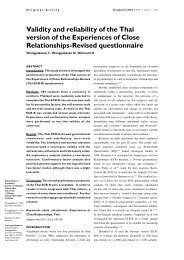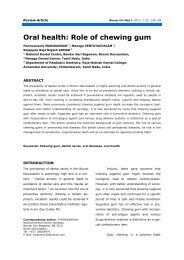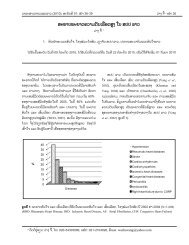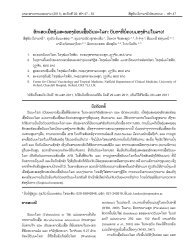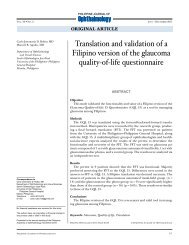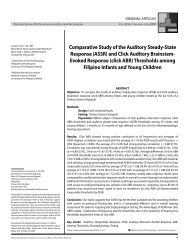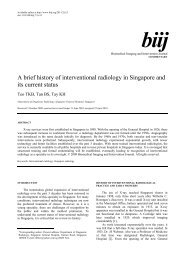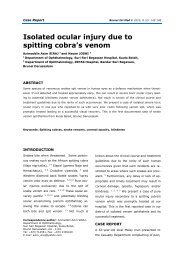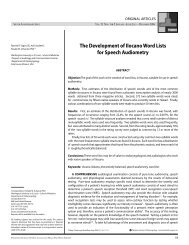PDF ( B) - APAMED Central
PDF ( B) - APAMED Central
PDF ( B) - APAMED Central
You also want an ePaper? Increase the reach of your titles
YUMPU automatically turns print PDFs into web optimized ePapers that Google loves.
Singapore Med J 2011; 52(4) : 249<br />
OS was 75.6% (95% confidence interval [CI] 67.0–84.2).<br />
82 (67%) patients were alive and had no disease. 33<br />
(27%) patients had died on review, 24 (20%) of whom<br />
died from CRC, seven (6%) from extra-colonic disease<br />
and two (1%) from other causes. The median age of death<br />
was 40 years. The overall five-year survival of patients<br />
with either CRC or extra-colonic cancer was 57.1% (95%<br />
CI 43.0–71.2) compared to 98.0% (95% CI 94.1–100.0)<br />
for those who had not developed cancer (Fig. 1). For<br />
cancer cases, the overall recurrence rate was 13.5% (n =<br />
7), of which four (7.7%) cases were distant metastasis and<br />
three (5.8%) were locoregional metastasis. Recurrence<br />
and DFS were not significantly different between IPAA<br />
and IRA (p = 0.486).<br />
Overall survival<br />
1.0<br />
0.8<br />
0.6<br />
0.4<br />
0.2<br />
FAP with<br />
cancer<br />
FAP without<br />
cancer<br />
FAP with<br />
cancer censored<br />
FAP without cancer<br />
FAP with cancer<br />
FAP without<br />
cancer censored<br />
Discussion<br />
FAP is an autosomal dominant multiorgan disease with<br />
variable expressivity. Inactivating mutations in the<br />
APC gene located on chromosome 5q21 (11) results in<br />
the characteristic development of multiple colorectal<br />
adenomatous polyps, which, without timely surgical<br />
intervention, would invariably develop into colorectal<br />
carcinoma in an individual by 35–40 years of age.<br />
FAP patients are also at risk of developing neoplasms<br />
in various tissues, such as osteomata of the jaw and<br />
skull bones, epidermoid cysts, congenital hypertrophy<br />
of the retinal pigment epithelium, dental anomalies,<br />
as well as gastric, duodenal, brain and desmoids<br />
tumours. These patients are noted to have a higher risk<br />
of developing brain tumours, papillary cancers of the<br />
thyroid and hepatoblastoma. (11,14,15)<br />
As a result of the autosomal dominant nature of this<br />
disease and the various phenotypes with which patients<br />
present, early diagnosis, treatment and careful followup<br />
of high-risk patients are essential. The development<br />
of FAP registries, in which pedigrees are constructed<br />
around an affected proband, is considered to be effective<br />
in structuring care for these patients and their families.<br />
Since its inauguration in 1989, the SPR has evolved into<br />
a service that is available to all doctors in Singapore<br />
in order to facilitate identification, surveillance and<br />
management of all FAP patients and their families. Its<br />
main objectives include the registration of all FAP<br />
families in Singapore so that at-risk individuals may be<br />
offered current screening procedures and treatments,<br />
as well as identification of family members for genetic<br />
testing and counselling services. The overall aim is to<br />
prevent the development of cancer in these high-risk<br />
patients. The workflow of the SPR is illustrated in Fig 2.<br />
The main benefits obtained from a detailed registry<br />
enable appropriate decisions to be made on the suitable<br />
0.0<br />
0 100 200 300 400<br />
Median follow-up (mths)<br />
Fig. 1 Comparison of survival between FAP patients with and<br />
without cancer (p < 0.0001).<br />
treatment for these young patients. It is paramount to<br />
provide the most appropriate treatment so as to reduce<br />
the risk of patients developing advanced CRC, and at the<br />
same time, ensuring that patients have the best possible<br />
quality of life. This is especially so for FAP patients who<br />
undergo radical surgery when they have no disabling<br />
clinical symptoms or only mild ones. The age of 30 years<br />
is a critical age for surgical prophylaxis, and colectomy<br />
should be offered from the age of 20 years. (6) This enables<br />
young patients to develop physically, grow in maturity in<br />
dealing with the disease as well as achieve educational<br />
and career milestones. These patients are thus able to<br />
complete crucial examinations or their tertiary/diploma<br />
education before undergoing surgery, which may take<br />
several months for complete recovery.<br />
The choice of surgery remains debatable. While<br />
IPAA was the most common procedure performed in<br />
our department, a relatively large number of IRAs were<br />
performed in both cancer cases and for prophylaxis.<br />
Restorative proctocolectomy was first described by Parks<br />
et al, (16) and was reported to eradicate all at-risk colorectal<br />
mucosa and maintain the anal canal with good functional<br />
results. IPAA thus appears to be the most appropriate<br />
procedure for FAP patients. IPAA is the procedure of<br />
choice in the presence of dysplasia in the rectum or<br />
rectal cancer. In our study cohort, the high incidence of<br />
rectal primary cancers (53%) and synchronous cancers in<br />
the rectum may suggest that IPAA should be advocated<br />
routinely in FAP patients. However, developing<br />
knowledge of the disease has suggested that IRA may be




